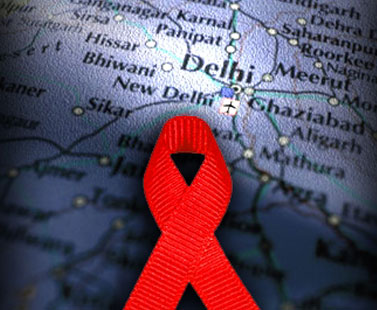
The spread from the high-risk behavior groups to the general populace is another key indicator that HIV/AIDs in India has reached epidemic proportions. The disease is no longer confined to high-risk behavior groups such as intravenous drug users and female sex workers and their clients. The clients, particularly married males, act as the bridge groups, aiding and abetting the spread of HIV/AIDS into the general population in India.
Both married and unmarried men visiting sex workers fuel this epidemic. Assessing the trends in high-risk groups, the study notes that testing for infection at sexually transmitted diseases [STD] clinics has revealed an alarming situation in many states. Even in Kerala, which is not considered a high prevalence state, more than two out of 100 STD patients tested positive for HIV.
In India, sexual transmission is responsible for 84 percent of reported HIV cases and HIV prevalence is high among sex workers (both male and female) and their clients. In Mumbai and Pune, for example, 54 percent and 49 percent of sex workers, respectively, were found to be HIV-positive (NACO, 2005). A large proportion of women with HIV appear to have acquired the virus from regular partners who were infected during paid sex.
IV prevention efforts targeted at sex workers are being implemented in India. However, the context of sex work is complex and enforcement of outdated laws often act as a barrier against effective HIV prevention and treatment efforts. Indeed, condom use is limited especially when commercial encounters take place in ‘risky’ locations with low police tolerance for this activity. In addition, interventions tend to primarily target brothel-based sex workers, who represent a minority of sex workers.
HIV information and awareness among sex workers appears to be low, especially among those working in the streets. Some prevention programs run by sex workers’ cooperatives —in Sonagachi, Kolkata, for example—have encouraged safe paid sex practices and have been associated with lower HIV prevalence.
In-depth thematic studies of drug use in the border areas, female drug users, drug use in rural areas and patterns of drug use in prison populations were also launched. A National Household Survey having a sample size of over 40,000 males in the 12-60 age group, documenting the extent, patterns and trends of drug use in India was a major part of the research collaboration. The link between poverty & gender discrimination are help to decline socio economic prosperity.
This link creates several anti social poisonous issues also. Such as trafficking to prostitute, sell sex for earn or living, break down family norm to create frustration and driven drug point. We notice easily that Illiteracy is the main watchword of all circumstance. So it is not easy to remove it from the society, several programs & strategy are needed to gain sustainable position.
Relatively little is known about the role of sex between men in India’s HIV epidemic, but the few studies that have examined this subject have found that a significant proportion of men in India do have sex with other men. In two states where data have been collected, HIV prevalence of 6.8 percent and 9.6 percent were found among MSM in Chennai and Mumbai, respectively (NACO, 2004). More recently, HIV prevalence of 12 percent was found among MSM seeking voluntary counseling and testing services in Mumbai, and 18 percent prevalence was found at 10 clinics in Andhra Pradesh.
In some areas, a substantial proportion of MSM also sell sex. Poor knowledge of HIV has been found in groups of MSM. The extent and effectiveness of India’s efforts to increase safe sex practices between MSM (and their other sex partners) will play a significant role in determining the scale and development of India’s HIV epidemic.
A Rapid Assessment Survey (RSA) of drug users in 14 cities collected and collated street-based information on drug use and drug-related HIV. In-depth thematic studies of drug use in the border areas, female drug users, drug use in rural areas and patterns of drug use in prison populations were also launched. A National Household Survey having a sample size of over 40,000 males in the 12-60 age group, documenting the extent, patterns and trends of drug use in India was a major part of the research collaboration.
RSAs conducted in Jamshedpur, Hyderabad, Bangalore, Shillong, Dimapur, Thiruvanthapuram, Goa, Ahmedabad, Imphal, Chennai, Mumbai, Delhi and Kolkata indicate that 43 per cent of clients interviewed had injected at some point. Needle sharing was reported by 53-85 per cent of injectors. Non-cleaning of needles/syringes was common and knowledge of modes of HIV/AIDS transmission was limited.
Consequently, risk-perception of HIV was low. Significantly, women drug users also reported injecting drug use. Clearly, there is need to extend interventions and prevention activities into areas other than the north-eastern states and particularly the metropolitan cities of India where injecting drug use is a problem. There are over 100,000 estimated injecting drug users in India outside of the north-eastern part of the country.
D. Nira Romachandran
India



